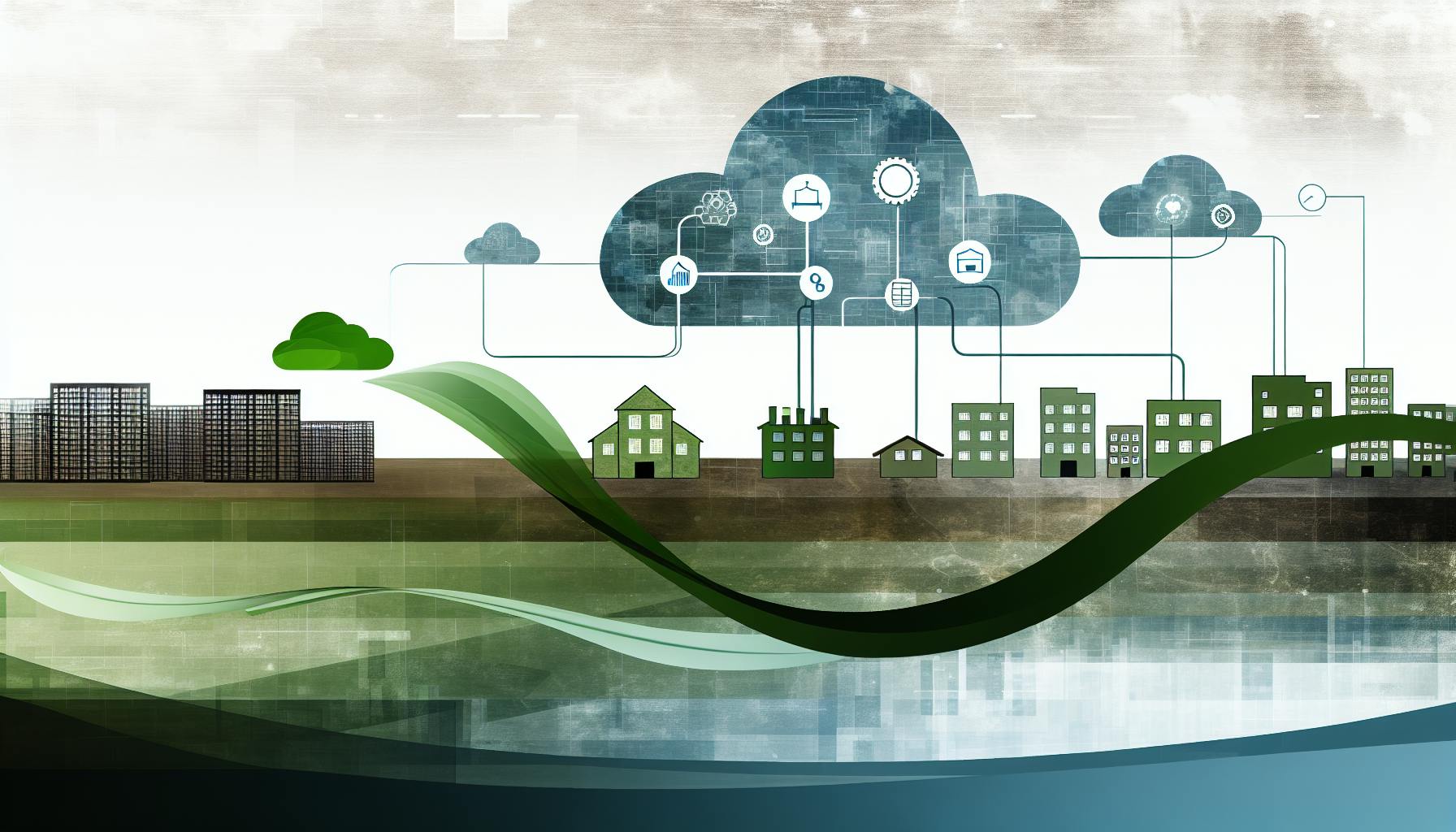Understanding greenhouse gas (GHG) sources is critical for businesses seeking to reduce their climate impact.
This article will provide a comprehensive overview of all major GHG sources, helping organisations accurately account for their carbon footprint and identify effective emission reduction strategies.
You'll learn the main GHG types, top global emission sources, how to quantify emissions across sectors and discover practical steps to lower your organisation's footprint while enabling sustainable development.
Unveiling the Spectrum of GHG Sources and Their Impact on Climate Change
Greenhouse gas (GHG) emissions from human activities are the primary driver of climate change. Understanding the sources of these emissions is crucial for businesses seeking to measure and reduce their carbon footprint. This article will provide an overview of key concepts, trends, and data related to GHG emissions, setting the stage for companies to take informed climate action.
Defining GHG Sources and the Greenhouse Gases List
GHG emissions refer to the release of gases that trap heat in the atmosphere, increasing surface temperatures on Earth. The main greenhouse gases are:
- Carbon dioxide (CO2)
- Methane (CH4)
- Nitrous oxide (N2O)
- Fluorinated gases
A carbon footprint measures the total GHG emissions caused directly and indirectly by an individual, organisation, event or product. It is measured in tonnes of carbon dioxide equivalent (tCO2e).
The global warming potential (GWP) of each gas quantifies its heat trapping capacity compared to CO2 over a fixed timeframe. For example, methane has a GWP of 28-36 over 100 years.
The Imperative of Accurate GHG Accounting for Climate Action
Investor and regulatory pressure for climate transparency is growing globally. Over 90% of S&P 500 companies published sustainability reports in 2019, demanding robust GHG accounting.
Tracking emissions against science-based targets and identifying reduction opportunities requires accurate, granular data across direct operations and supply chains. This article provides key insights for this undertaking.
Overview of Global Greenhouse Gas Emissions
The top GHG emitting countries currently include China (27%), U.S. (11%), EU (8%) and India (7%). Key sectors are electricity/heat (31%), agriculture (16%), transportation (15%), forestry (10%) etc.
While progress has been made, emissions must fall by 7.6% annually from 2020 to 2030 to reach net-zero by 2050 and meet Paris Agreement goals.
The Relationship Between Human Activities and GHG Emissions
The greenhouse gases emitted today will still impact temperatures for years due to long atmospheric lifetimes. Urgent action across sectors is needed to mitigate worst case climate scenarios.
This article explores the activities driving emissions across sectors, empowering readers with knowledge to contribute to solutions.
What are the 6 major sources of GHGs?
The main sources of greenhouse gas (GHG) emissions globally are:
- Electricity and Heat Production (31%) - Burning fossil fuels like coal, oil, and natural gas to generate electricity and heat is the largest single source of global GHG emissions. This includes emissions from power plants, industrial facilities, and other applications.
- Agriculture (11%) - Agricultural activities like livestock, soil management, and rice cultivation produce significant methane and nitrous oxide emissions. Cattle digestion and manure management account for the majority of agricultural emissions.
- Transportation (15%) - The burning of petroleum-based fuels like gasoline and diesel in cars, trucks, ships, trains, and airplanes comprises a major share of global emissions. Most transportation emissions come from road vehicles.
- Forestry (6%) - Deforestation and forest degradation contribute to climate change through CO2 released from vegetation and soil disturbance. The forestry sector also provides carbon sequestration opportunities.
- Manufacturing and Construction (12%) - Several industrial processes and product uses emit potent GHGs like hydrofluorocarbons, perfluorocarbons, sulfur hexafluoride, and nitrous oxide. Cement production is also a major source of CO2 emissions globally.
- Commercial and Residential (12%) - Heating and cooling, lighting, and using appliances and equipment in homes, offices, shops, restaurants, warehouses, schools, hospitals, hotels and other buildings burn fossil fuels and emit CO2 as well as smaller amounts of methane and nitrous oxide.
Together, these 6 categories comprise the majority of total global greenhouse gas emissions from human activity. Understanding the sources allows businesses to accurately measure their carbon footprint and identify reduction opportunities.
What are 5 natural sources of greenhouse gases?
Greenhouse gases occur naturally in the environment from various sources. Here are 5 of the major natural sources of greenhouse gas emissions:
- Forest fires: Forest fires release carbon dioxide, methane, and nitrous oxide into the atmosphere. As vegetation burns, stored carbon is released. Fires can also disturb soil and release soil carbon.
- Oceans: Oceans are a major natural source of carbon dioxide. As seawater absorbs CO2, chemical reactions produce carbonic acid which can release the gas back into the air. Warming oceans may also release more CO2.
- Wetlands: Inundated wetland environments support microbes that produce methane through anaerobic respiration and fermentation. This can be released into the air.
- Permafrost: Frozen permafrost soils contain organic matter. As permafrost thaws due to rising temperatures, this organic material decays, releasing CO2 and methane.
- Volcanic eruptions: Volcanoes emit carbon dioxide that was stored deep underground. Major eruptions can release large amounts of CO2 into the atmosphere.
Tracking natural greenhouse gas sources can help scientists model the global carbon cycle. While human activity now releases far more greenhouse gases, quantifying all emissions sources is key for climate change projections and mitigation strategies.
What are the 4 most common GHG?
The four most common greenhouse gases (GHGs) that contribute to climate change are:
- Carbon dioxide (CO2): Primarily emitted from burning fossil fuels like coal, oil, and natural gas. Other sources include cement production, deforestation, and land use changes. CO2 makes up over 75% of global GHG emissions.
- Methane (CH4): Released during fossil fuel extraction and livestock digestion. Methane has more than 25 times the global warming potential of CO2 over a 100-year period.
- Nitrous oxide (N2O): Mainly emitted from agricultural soils and manure management. N2O has about 298 times the global warming potential of CO2 over a 100-year timeframe.
- Fluorinated gases: Potent GHGs used in refrigeration, aluminum production, and other industrial processes. Includes hydrofluorocarbons (HFCs), perfluorocarbons (PFCs), sulfur hexafluoride (SF6) and nitrogen trifluoride (NF3). They can be thousands of times more effective at trapping heat than CO2.
Accurately tracking emissions from these major GHG sources is crucial for businesses to measure, report on, and reduce their carbon footprint. Using automated tools simplifies this complex accounting process.
What is the biggest contributor to GHG?
The biggest contributor to greenhouse gas (GHG) emissions globally is the burning of fossil fuels. This includes the use of coal, oil, and natural gas across sectors like electricity production, transportation, buildings, manufacturing, and agriculture.
Fossil fuel combustion accounts for over 75% of total global GHG emissions. Specifically, it makes up:
- Coal: Contributes to 46% of CO2 emissions from fossil fuel combustion. Used in electricity production, iron and steel making, cement manufacturing, and other industrial processes.
- Oil: Accounts for 34% of CO2 emissions. Used for transportation, heating, petrochemical production, and electricity generation.
- Natural gas: 19% of emissions. Used for electricity, heating, cooking, transportation, and as a petrochemical feedstock.
The main greenhouse gas emitted from fossil fuel combustion is carbon dioxide (CO2). When burned, fossil fuels release the carbon stored underground as CO2 into the atmosphere. This CO2 builds up and traps heat, causing the greenhouse effect and global warming.
Other GHGs released from fossil fuel use include methane from natural gas systems, nitrous oxide from fuel combustion, and fluorinated gases from electricity transmission and distribution systems.
Reducing reliance on fossil fuels across economic sectors is crucial to limiting GHG emissions and climate change. Transitioning to renewable energy sources like solar, wind, hydroelectric, geothermal, and bioenergy can decrease humanity's carbon footprint over time.
sbb-itb-919600f
Major Sources of GHG Emissions
Fossil fuel combustion from sectors like power, industry, and transport is the leading source of global greenhouse gas (GHG) emissions. As the world continues to rely heavily on oil, coal, and natural gas, CO2 emissions from burning these fuels contribute significantly to climate change.
Strategies to reduce emissions from fossil fuel use include transitioning to renewable energy sources like solar and wind, improving energy efficiency across sectors, and deploying carbon capture and storage technology. Government policies like carbon pricing and clean energy incentives can also help drive an energy transition.
Fossil Fuel Combustion: The Leading Culprit
Fossil fuel combustion accounted for over 70% of total global GHG emissions in 2019. The power sector dominates, with coal and natural gas power plants emitting over 13 GtCO2e in 2019. But transport, buildings, and manufacturing industries also burn significant volumes of fossil fuels.
As developing countries industrialize rapidly, their reliance on fossil fuels for cheap baseload power and feedstock is driving growth in global emissions. For example, coal use for power in Asia Pacific grew over 65% from 2000 to 2018.
Targeted policies and collaborative action across countries and sectors are vital to curb emissions from fossil fuel use. Phasing out coal power, improving vehicle fuel efficiency, switching to electric heating and cooling, and optimizing energy-intensive industrial processes can all contribute to a low-carbon transition.
Industrial Emissions: Processes and Solutions
Several carbon-intensive industrial processes used in sectors like cement, steel, and chemical production also generate substantial GHG emissions.
In 2019, emissions from industrial processes contributed to over 8% of global GHG emissions. Key sources include mineral production, metal smelting, and the production and use of chemicals like ammonia. Energy-intensive reactions during these processes often release CO2 and other potent GHGs.
Strategies for reducing industrial process emissions include material efficiency, recycling, fuel switching, and innovative production methods. For example, the steel industry can transition from using carbon-intensive blast furnace production to electric arc furnace steelmaking fueled by renewable electricity. Cement makers can use alternative raw materials, optimize fuel mix, and improve energy efficiency.
Government support, public-private collaborations, and industry commitments to net-zero transitions can help drive rapid progress in cutting industrial emissions.
Agricultural Emissions: Understanding the Environmental Cost
The agriculture sector generates over 10% of total global GHG emissions, the majority from livestock rearing and rice cultivation. Ruminant animals like cows and sheep emit methane as part of their digestive process, while synthetic fertilizers release nitrous oxide.
With rising populations and shifting diets towards more meat and dairy, agricultural emissions are projected to grow over 15% by 2030 unless mitigation measures are adopted. Sustainable solutions include using biogas digesters to manage manure, improving cattle breeding and health to reduce methane outputs, and optimizing fertilizer application techniques.
Incentivizing farmers and ranchers to adopt climate-smart practices through government programs and supply chain sustainability initiatives can help minimize agriculture's climate impact.
Deforestation and Land Use Change: Hidden Drivers of Climate Change
Deforestation and land use changes also influence GHG dynamics significantly. Forests act as carbon sinks, absorbing CO2 from the atmosphere. Rampant deforestation destroys these sinks and releases stored carbon back into the air.
Between 2015-2020, deforestation emitted over 8 GtCO2e globally. Forest conservation policies, sustainable forest management practices, and restoring degraded land can help preserve vital carbon sinks while supporting rural livelihoods.
As a major driver of deforestation, the expansion of agriculture also leads to soil disturbance and loss of soil carbon to the atmosphere. Sustainable land use planning and climate-smart farming techniques can mitigate such emissions.
Transportation Emissions: The Road to a Lower Carbon Future
Transportation produces nearly 15% of global human-caused GHG emissions. Road vehicles dominate, but aviation, rail, and marine transport also contribute significantly. Fossil fuel combustion during transportation releases CO2, methane, nitrous oxide, and black carbon particles.
While the Renewable Fuel Standard mandates blending biofuels like ethanol into gasoline to reduce emissions, more comprehensive policies and innovations are essential for deep decarbonization. Governments worldwide are announcing plans to phase out gasoline vehicles and accelerate the transition to electric mobility. Improving public transit infrastructure and shifting towards more sustainable aviation fuels can further curb transport emissions.
Quantifying Your Carbon Footprint Through GHG Accounting
Accurately assessing your company's carbon footprint is an essential first step towards reducing your climate impact. By quantifying emissions across all scopes and sources, you gain visibility into your greatest risks and opportunities.
Setting Organizational Boundaries for Emissions Monitoring
When calculating your carbon footprint, you must first determine your organizational boundaries. This involves deciding which operations to include - subsidiaries, joint ventures, franchises, etc. As a general rule, account for any entities where you have financial or operational control.
Gather details on the ownership share of each operation and consolidate emissions data appropriately. Refer to accepted GHG accounting standards like the Greenhouse Gas Protocol to set precise boundaries. Defining clear boundaries ensures all relevant emissions sources are captured.
Collecting Activity Data for a Comprehensive Greenhouse Gas Inventory
Once organizational boundaries are set, data collection begins. Your greenhouse gas inventory should capture all material emission sources across Scopes 1, 2 and 3.
For Scope 1 and 2, compile energy, fuel and refrigerant usage records. For Scope 3, collect supplier data and logistics/travel details. Utilize emission factors to convert activity data into CO2 equivalents. Maintain organized records for periodic reporting.
Assemble a centralized database of emissions factors relevant to your operations. Regularly update factors to reflect emissions intensities of purchased electricity, fuels and supply chains.
Life-Cycle Assessment: A Tool for Deeper Insight
While GHG inventories quantify emissions from owned sources, life-cycle assessments estimate impacts across the full product life-cycle. An LCA evaluates raw material extraction, production, distribution and end-of-life phases to calculate total footprint.
For consumer goods companies, LCAs let you identify carbon hotspots your product's life-cycle. Results can steer R&D efforts towards sustainable materials and greener production methods. LCAs provide a comprehensive picture for branding and ESG communications.
The Role of Carbon Sequestration in GHG Reduction
Carbon sequestration via nature-based solutions like reforestation can effectively offset emissions. As part of your net-zero strategy, invest in certified carbon removal projects to counterbalance hard-to-abate emissions.
When reporting to stakeholders, disclose details of sequestration projects and ensure credits are verified and counted just once. Be realistic about the scale needed - prioritize reducing emissions outright before compensating through offsets. Evaluate sequestration's permanence and include buffer credits in case of reversals.
Strategies for Emission Reduction and Sustainable Development
Reducing greenhouse gas (GHG) emissions is critical to mitigating climate change and promoting sustainable development. Businesses across all sectors have an important role to play by implementing targeted emission reduction strategies.
Advancing Energy Efficiency and Renewable Energy Transition
Transitioning to renewable energy sources is one of the most impactful ways for companies to reduce their carbon footprint. Key strategies include:
- Conducting energy audits to identify efficiency opportunities
- Upgrading equipment, appliances, lighting to more efficient models
- Installing on-site renewable energy like solar PV or wind turbines
- Procuring renewable electricity from utility-scale sources
- Phasing out fossil fuel-powered systems and transitioning to renewable alternatives
Focusing efforts on improving energy efficiency and increasing renewable energy adoption can significantly lower GHG emissions from power consumption.
Smart Growth: Urban Planning for Lower GHG Emissions
Smart urban planning helps create compact, walkable, and transit-oriented communities that have lower carbon footprints. Businesses should consider smart growth principles such as:
- Locating offices/facilities near public transit hubs
- Encouraging telecommuting and remote work options
- Designing spaces for pedestrian and cycling access
- Advocating for mixed-use zoning
- Supporting urban forests and green spaces
By influencing urban developments in these ways, companies can promote emissions reduction through sustainable mobility and land use.
Sustainable Procurement and Supply Chain Management
Managing supply chain sustainability involves setting procurement standards that account for environmental impacts of sourced goods/services. Key supply chain strategies include:
- Assessing lifecycle emissions of purchased products
- Prioritizing local sourcing to reduce transport miles
- Selecting low-carbon raw materials and production processes
- Requiring sustainability certifications from suppliers
- Engaging suppliers to lower their GHG footprints
Implementing sustainable procurement through supplier engagement and streamlined value chains is vital for mitigating emissions.
Innovative Solutions for Industrial and Agricultural Emission Control
Emerging technologies provide new ways for industrial manufacturers and farmers to control their GHG emissions:
- Installing renewable energy systems onsite (solar, wind, bioenergy)
- Improving energy efficiency of machinery and processes
- Capturing and storing carbon emissions
- Using precision agriculture to optimize inputs and reduce nitrous oxide
- Switching to organic agriculture to sequester more soil carbon
- Converting waste into energy to lower methane and use fewer fossil fuels
Leveraging these innovative systems can create industrial and agricultural operations that are far less carbon-intensive.
Global Perspectives on GHG Emissions: By Sector and Country
Understanding greenhouse gas (GHG) emissions by sector and country provides critical insights for climate change mitigation efforts. As the world seeks to curb emissions and transition to net-zero economies, examining the sources and distribution of emissions reveals where the greatest challenges and opportunities lie.
Greenhouse Gas Emissions by Sector: A Comparative Analysis
When analyzing global greenhouse gas emissions, key sectors driving emissions include:
- Energy - Burning fossil fuels for electricity, heat, and transportation accounts for nearly 75% of global GHG emissions. Key sources are power generation, industry, buildings, and transport.
- Agriculture - Agricultural activities generate nearly 13% of emissions, through livestock, soil management, rice cultivation, biomass burning, and more.
- Land-use change and forestry - Converting forests to agricultural land or settlements accounts for 11% of emissions by reducing carbon dioxide absorption.
- Waste - Landfills and wastewater produce methane and nitrous oxide, contributing 3-4% of global emissions.
Tracking emissions across these sectors over time shows the energy sector dominating, but also that emissions from industry and transport are rising rapidly. This suggests that deep decarbonization of energy systems combined with efficiency gains in industry and mobility systems need to be prioritized globally.
Emission Intensity and GWP: Metrics for International Comparison
Emission intensity and Global Warming Potential (GWP) offer standardized ways to compare emissions across countries and sectors.
Emission intensity measures emissions per unit of economic output. It highlights how much pollution is generated per unit of growth, allowing comparisons of the carbon efficiency of different economies.
GWP measures how much heat a greenhouse gas traps in the atmosphere over a period of time, relative to carbon dioxide. It enables converting emissions of various gases into a common measure expressed as CO2 equivalent (CO2eq).
Using GWP and emission intensity together builds understanding of not just the scale, but also the nature and efficiency of emissions globally.
Greenhouse Gas Emissions by Country Per Capita
Analyzing per capita emissions reveals stark disparities in contributions to climate change globally.
Many developed countries show high per capita emissions - led by major economies like the United States, Canada, and Australia. Developing nations often have lower per capita emissions, but rapid growth can increase contributions over time.
These mismatches between nations' outputs and inputs into climate change drive debates around equity and climate justice. They also demonstrate that effectively tackling emissions requires coordinated global action combining development priorities with climate responses.
The Role of Climate Change Mitigation in Reducing Global Emissions
Mitigating climate change through transitions to clean energy, ecosystem protection, and climate-smart agriculture and infrastructure is crucial to reducing GHG emissions.
Key policies adopted globally include carbon pricing mechanisms, clean energy mandates and incentives, efficiency standards, sustainable land-use policies, and nature-based solutions.
Combined with shifts in technology, development pathways, and consumer behaviors, ambitious climate change mitigation efforts can curb emissions growth and set the world on a path to net-zero.
Key Takeaways and Next Steps Towards a Low-Carbon Future
Summarizing the Central Role of Accurate Carbon Accounting
Accurately measuring and reporting greenhouse gas (GHG) emissions is the critical first step for any business seeking to reduce its carbon footprint. By developing a detailed emissions inventory using methodologies like the Greenhouse Gas Protocol, companies can identify the largest sources of emissions across their operations and supply chain. This carbon accounting process builds an essential foundation from which to develop and implement emissions reduction strategies.
Regularly monitoring and reporting emissions also enables companies to track progress over time as new abatement measures are introduced. As the saying goes: "what gets measured gets managed." Rigorous carbon accounting integrates sustainability into day-to-day decision making by making the invisible visible.
Getting Started on Lowering Your Footprint: Practical Measures
Once a detailed carbon footprint assessment has been completed, companies can use the findings to search for emissions reduction opportunities. Some common areas to target include improving energy efficiency in facilities, switching to renewable power, electrifying vehicle fleets, reducing business travel, implementing circular economy practices, and engaging suppliers on lowering supply chain impacts.
Prioritizing the largest emission sources for early reduction efforts will have an outsized impact. Companies should focus on interventions that balance cost, feasibility, and emissions abatement potential. Government incentives like tax credits can also help improve the business case for sustainability investments.
The Importance of Emissions Monitoring and Reporting
Continuously monitoring and reporting GHG emissions over time is crucial for companies to track performance against baseline emissions and reduction targets. Regular emissions reports help embed climate consciousness into operations, allowing for course correction if new initiatives underperform.
Public emissions reporting also helps demonstrate accountability to external stakeholders like investors, policymakers, and consumers who are increasingly demanding corporate climate action. Transparency builds trust and social license to operate.
As new regulations emerge requiring corporate emissions disclosures, accurate carbon accounting positions companies to easily comply. It also enables robust data to inform ambitious science-based target setting.
Fostering Sustainable Development Through Climate Action
Beyond mere compliance, aggressively reducing GHG emissions is central to sustainable development for any business. Mitigating climate change promotes environmental health and social justice for communities worldwide.
First movers who drive deep decarbonization of their operations and value chains will gain competitive advantage as sustainable business practices become the global norm. Climate action also allows companies to attract and retain top talent, especially among purpose-driven younger demographics.
By viewing sustainability as an opportunity rather than an obligation, businesses can future-proof growth while benefiting people and planet. The emissions reduction journey begins with understanding your carbon footprint.


.png)


